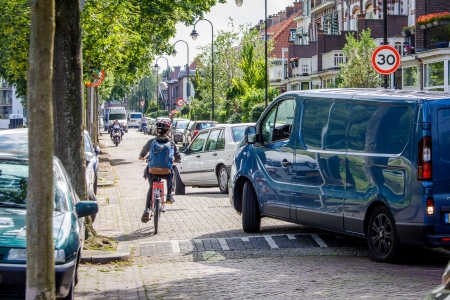The design principle (Bio)mechanics implies that traffic flows and transport modes are compatible with respect to speed, direction, mass, size and degree of protection. This is supported by the design of the road, the road environment, the vehicle, and, where necessary, additional protective devices. For two-wheeled vehicles, it is important that the road and the road environment contribute to the stability of the rider.
In cases where (bio)mechanic compatibility between road users, their mode of transport and the road layout is still insufficient, the speed of all traffic should be adapted to the most vulnerable transport modes (in particular, walking and cycling) and road users (in particular, children and seniors; see [7] en [8]).
A detailed elaboration of the (bio)mechanics principle distinguishes between roads with a flow function and roads with an exchange function. Apart from this there are additional principles for cyclists.
Where traffic flows: Either physically or in time, motorized traffic is separated from low speed traffic, from traffic travelling in the opposite direction, from traffic with a substantially different mass or width, and from hazardous obstacles (see also [4] en [7]). For example: cyclists ride on a bicycle track and are directed by conflict-free traffic lights at intersections. The road and the immediate road environment are forgiving, which means that they are designed and built in such a way that the free flow speed is safe (see Table 1).
Furthermore, road users will be sufficiently physically protected by the vehicle or by protection devices on their bodies. For example: drivers are protected by rigid occupant compartments and other safety devices in the car; a motorcyclist wears a motorcycle outfit and an appropriate helmet. If a mode of transport cannot meet the speed, mass, size and road user protection criteria that are necessary for safe flowing, then this mode will not be allowed on roads intended for a flow function (through-roads or distributor roads). For such transport modes, special infrastructure is provided that is adapted to traffic with lower speed and smaller size, mass, and less protection. For example: cyclists and tractors are not allowed on 80km/h roads, whereas they are allowed on the adjacent service road with a lower speed limit. Incidentally, the latter may result in a different incompatibility: viz. the difference in mass and size between tractors and cyclists (who, moreover, lack adequate physical protection).
Where traffic exchanges: high-speed traffic drives at a safe lower speed in situations in which traffic has an exchange function. For example: speed at intersections is lower than speed on road sections, and in home zones and shopping zones speed is lower than on through-roads. This should minimize crash risk and crash consequences for vulnerable road users in particular (see for example [4], [7] and [8]). Road layout and the vehicle itself help achieve these lower speeds (see the Psychologics principle).
Apart from this, the road should offer enough room for passing and overtaking other road users.
Additional point of interest for the safety of cyclists: to prevent bicycle crashes that don’t involve motorized vehicles, and single-vehicle cyclist crashes, cyclists should have sufficient room for manoeuvring at low speed, a clean and skid-resistant road surface and a forgiving road environment without stability-undermining elements (e.g., sharp-edged elevation differences, obstacles; see [9], [10], [11] and [12]). In addition, they have made themselves adequately protected against injury if they fall (for example by means of a bicycle helmet) in cases where the road and road environment are not yet forgiving enough.
|
Potential conflicts and requirements associated with |
Safe speed (km/h) |
|
Possible conflicts with vulnerable road users in home zones (no foot paths and pedestrians using the carriageway) |
15
|
|
Possible conflicts with vulnerable road users on roads and at intersections, including situations with bike lanes or advisory bike lanes |
30 |
|
No conflicts with vulnerable road users, except with helmet-protected riders of motorised two-wheelers (mopeds on the carriageway). Possible right-angle conflicts between motorised vehicles, possible frontal conflicts between motorised vehicles. Stopping sight distance ≥ 47 m |
50 |
|
No conflicts with vulnerable road users No right-angle conflicts between motorised vehicles, possible frontal conflicts between motorised vehicles Obstacles shielded or obstacle-free zone ≥ 2.5 m, (semi)hard shoulder Stopping sight distance ≥ 64 m |
60 |
|
No conflicts with vulnerable road users No right-angle conflicts between motorised vehicles, possible frontal conflicts between motorised vehicles Obstacles shielded or obstacle-free zone ≥ 4.5 m, (semi)hard shoulder Stopping sight distance ≥ 82 m |
70 |
|
No conflicts with vulnerable road users No right-angle or frontal conflicts between motorised vehicles Obstacles shielded or obstacle-free zone ≥ 6 m, (semi)hard shoulder Stopping sight distance ≥ 105 m |
80 |
|
No conflicts with vulnerable road users No right-angle or frontal conflicts between motorised vehicles Obstacles shielded or obstacle-free zone ≥ 10 m, hard shoulder Stopping sight distance ≥ 170 m |
100 |
|
No conflicts with vulnerable road users No right-angle or frontal conflicts between motorised vehicles Obstacles shielded or obstacle-free zone ≥ 13 m, hard shoulder Stopping sight distance ≥ 260 m |
120 |
|
No conflicts with vulnerable road users No right-angle or frontal conflicts between motorised vehicles Obstacles shielded or obstacle-free zone ≥ 14.5 m, hard shoulder Stopping sight distance ≥ 315 m |
130 |
Table 1. Further elaboration of ‘safe speed limits’.[i] Differences with the row above are indicated in bold
See Aarts & Dijkstra [6], Chapter 4, for further information about the design principle (Bio)mechanics.
[i] Potential conflict situations demanding a maximum speed of 15km/h are based on [13]. Potential conflict situations and design requirements linked to safe speed limits between 30 and 120 km/h are based on [7] en [14]. Design requirements for safe travel on roads at 130 km/h have provisionally been specified but need further study.
